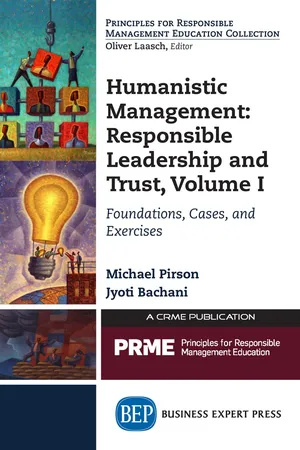![]()
PART I
Responsible Leadership—A
Humanistic Perspective
![]()
CHAPTER 1
A Humanistic Perspective
on Leadership
Michael Pirson
Leadership is a much beloved term in the Anglo-Saxon world and beyond, and being a leader is seen as an important quality. There is however much confusion of what a good leader is and humanity has suffered substantially from bad leadership. In this chapter, I outline a science-based perspective on good leadership, which draws on evolutionary theory and the work of Paul Lawrence. Evolutionary theory allows us to understand what made the human species survive throughout the thousands of years. This perspective can help illuminate why our species seems on the brink of extinction and how it can be avoided, if and when better leadership is provided.
The Baseline Model
Evolutionary biology points to four independent drives of human nature, which are critical for the survival of the species. Darwin suggests that we share an evolutionary background with many animals, while neuroscience’s insights point to deeply rooted neural mechanisms that reward us when we acquire and defend what we deem necessary for survival. Lawrence and Nohria (2002) label two basic drives that we share with all animals as (a) the drive to acquire (dA) and (b) the drive to defend (dD).
The Drive to Acquire (dA)
Lawrence argues that humans, in common with all animals, have a fundamental drive to get what they need to stay alive and have progeny: food, water, warmth, sex, and so on. Modern neuroscience provides evidence to support the biological basis of the drive to acquire. Researchers found, for example, that an area in the brain called the “nucleus accumbens” lights up with increased blood flow when people and animals experience pleasurable sensations from objects they encounter, ranging from tasty food to the sight of a beautiful face. This drive is commonly acknowledged by many economic and management theorists, including Jensen and Meckling, as the basis for utility maximization.
The Drive to Defend (dD)
Lawrence and Nohria claim that in most species the drive to defend is a mirror image of the drive to acquire. What needs defending is what is needed to be acquired—food, water, warmth, mates, and so on. Carter and Frith present evidence that the drive to defend seems, like the other drives, to be housed in the limbic area of the brain, specifically in a module called the “amygdala.” Carter and Frith explain that the amygdala acts as the brain’s alarm system. Depending on the situation, the amygdala may issue a feeling of panic, which translates into a flight mechanism. However, it could also stimulate excessively friendly behavior to appease the opponent. A third response could be to fight, which is increasingly inappropriate in modern civilizations. Lawrence and Nohria further argue that, in humans, the drive to defend means far more—not only the physical necessities of life and procreation, but also relationships, cooperative efforts, and world views (see the idea of protected values). Similar to the drive to acquire, humans can satisfy their drive to defend in a huge variety of ways, and often in cooperation with others.
A Humanistic Extension
Simplified, the two drives (drive to acquire and drive to defend) go far to explain the economistic perspective on human nature. The economistic perspective views human beings as fundamentally egoistic, amoral utility maximizers (Homo economicus). Within this perspective, all other drives and interests are subordinate to the ambition to maximize the drive to acquire. Spencer’s account of Darwin’s findings reduced human behavior largely to a two-drive model, which subordinated all other human concerns to the impetus of acquiring and defending.
The novelty of the recent evolutionary findings and their importance lie in the addition of two important and independent drives, or what Lawrence and Nohria label (1) the drive to bond (dB) and (2) the drive to comprehend (dC). Based on these findings, Lawrence developed a renewed Darwinian theory (RD theory), which rehabilitates Darwin’s groundbreaking insights into human behavior, which are often overlooked or misunderstood. In essence, RD theory explains how the human brain has developed via natural selection, as well as through sex and group selection mechanisms, to make complex decisions about all aspects of life (personal, communal, and societal). This theory posits that the two additional drives are independent of the other drives and represent critical ultimate motives that underlie all human decisions: The drive to bond (dB) enables long-term, mutually caring relationships with other humans, and the drive to comprehend (dC) allows us to make sense of the world around us in terms of its multifaceted relations with ourselves. In Darwin’s own words:
The small strength and speed of man, his want of natural weapons, etc., ...
